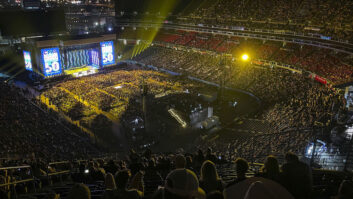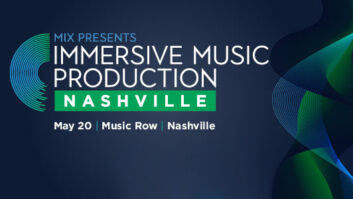NASHVILLE, TN—It’s no exaggeration to say that the CMA Music Festival, held every June in Nashville, is a big deal. The 2015 edition saw a daily attendance of more than 87,000, and generated a record $46.8 million in direct visitor spending, easily making it the city’s biggest annual event. While it’s become a top tourism draw for Nashville, however, the festival has also become a key artist development tool for the country music industry. Performances at the festival can provide a substantial career boost, so a lot is riding on them. Unsurprisingly, that means a lot is riding on the sound as well.
Morris Light & Sound provided a Nexo PA and Yamaha consoles for the Riverfront Stage at Nashville’s CMA Music Festival. Morris Light & Sound (Nashville, TN) supplied production support on four of the CMA stages, choosing the Nexo STM at the festival’s premier location. The Chevrolet Riverfront Stage, which housed the STM rig, also used four Yamaha CL5 digital audio consoles—two at front of house and two at monitors with four Rio 3224-D input/ output boxes. On the majority of the four-day festival, the Riverfront Stage saw a capacity crowd of more than 22,000 concertgoers, with performances including the Swon Brothers, Diamond Rio, Phil Vassar, Jack Ingram and Tanya Tucker, among others.

The STM system layout consisted of 42 M46s, 42 STM B112 sub bass for the main and side hang, four STM M28s for downfill with 32 STM S118 subs, and six PS10s for front fill. “The beautiful thing about the Nexo STM is that when it is out of the box, it is already nearly up and running,” said Mark Bollenberg, system tech and front of house engineer. “We confirmed the whole set up with Smaart staying coherent and in magnitude and then phase-aligned the S118 subs to the main hang, which was very nice because you can actually see where your phase is going.”
There were A and B Yamaha console systems at the Riverfront Stage, so while one act was performing, the other was open for the next act’s engineer to work on drums and bass sounds. During the 15-minute changeover, either Trey Smith—system tech/engineer at the A console—or Bollenberg at the B console would assign the necessary channels to a custom fader layer and off they’d go.
“What I love about the Yamaha CL5 is the ability to do the custom fader banks, and as the patch is called, to be able to assign what faders we need on the customs by quickly clicking through and selecting the faders I want to be in,” said Smith. “And, all of a sudden, we’ve got everything we need; it’s all there for the guest engineer to come up and start mixing his show, which is amazing because of the quick 15 minutes for set changes between each act.”
The BMI and Close Up stages each used Yamaha CL5s, and the Durango Stage used two Yamaha QL5 digital audio consoles. The Close Up Stage featured Little Big Town, Hunter Hayes, Kellie Pickler, Jo Dee Messina, and others. Lee Roy Parnell, Bellamy Brothers, and Mickey Gilley were some of the Durango Stage headliners, and the BMI Tail Gate Party stage featured Kane Brown, Chris Lane, DJ DU, and more.
“There are several things I really love about the Yamaha CL5 console,” said guest engineer Jason McLaren, front of house engineer for Jack Ingram, who performed on the Riverfront Stage mixing the CL5. “The head amps and the console sounds fantastic. But what I love the most about the console is how good the workflow is; when a workflow is intuitive, it means you can think about the music and about how you’re trying to mix instead of thinking about your tools. This makes a big difference to me and the quality of the work I’m able to do.”
Nexo/Yamaha
yamahaca.com







